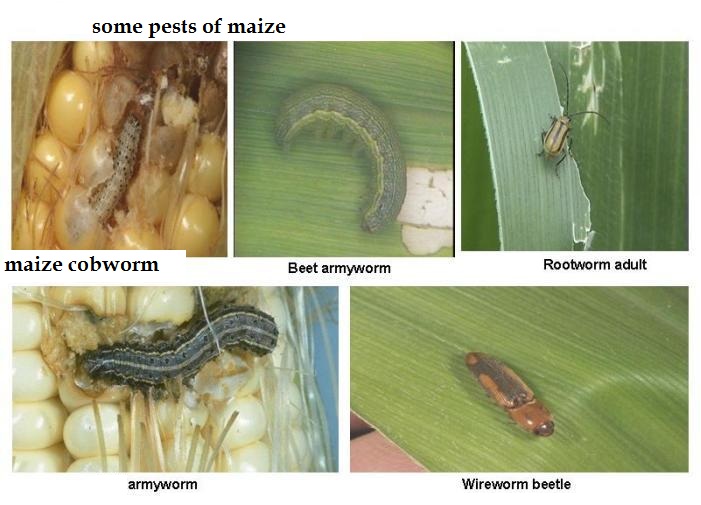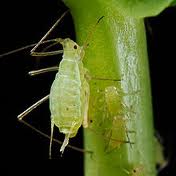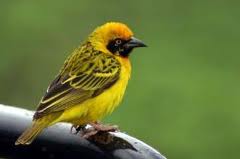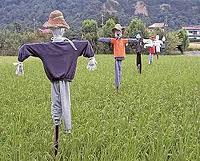Pests are organisms that feed on and destroy or damage crops in the field or in storage.
Examples of pests are insects, birds, and rats.
There are two types of pests, namely:
Field pests and Storage pests.

They attack the crops that are still growing or waiting to be harvested in the field or shamba.
Examples of field pests are:
• Cutworm. This worm attacks the seedlings as they emerge out of the soil.
The worms burrow just below the soil surface where they cut and eat the soft young shoots.
With the tip already nipped out, the plant may die.
• Aphid. This is a black insect with no wings.
It’s mouthparts are able to pierce the stem, leaf stalk and leaves of a plant in order to suck the plant juices.
This makes the plants weak and therefore unlikely to produce a good harvest.
Picture of an Aphid

Picture of a Cutworm
Maize stalk borer
Stalk borer damage to maize stalk
• Weaverbird
This is a bird that attacks cereals like maize.
It eats the grain and therefore reduces the yield.

These are the pests that attack the harvested crops when in storage.
Examples of storage pests are:
• Weevils. They are insects that make holes in stored cereals like maize, rice and millet.
They live and eat it from within the cereal.
• Termites or white ants. They often eat the harvest for example grains which are often covered with the soil that form their home (nest).
• Rodents. These are small animals that chew stored grains.
Rodents include moles, rats and squirrels.

Pests affect crops in the following ways:
1. They lower or reduce harvest.
A lower yield or a loss may be brought about by mature or stored crop or harvest being eaten by pests.
2. Reduced quality of produce for instance cereals with holes in them made by the weevils.
Such grains have a lower weight and mass since some of their parts have been eaten.
3. Pests that suck plant juices transmit diseases from unhealthy plants to healthy plants.
The infected plant may then die or produce a lower yield.
4. Diseases may also be transmitted to consumers from the plants that are infested by pests.
For instance, the rotting bodies of weevils and other insects and the excreta of such pests as rats and cockroaches spoil stored food by introducing germs which may cause diseases in people who eat it.
The excreta of birds dropped on grain being dried in open air may lead to food poisoning to people who eat the grain.
Packed maize flour sometimes contain a lot of weevils, making it unfit for human consumption.
To eliminate or reduce wastage of crops and improve harvest, pests must be controlled.
The methods of controlling pests include:
1. Trapping This method can be applied to rodents and birds in food storage sheds.
2. Handpicking Insects like weevils can be removed by hand.
Alternatively, the affected plants or parts of the plant can be uprooted (removed by hand).
The affected parts can then be destroyed by burning.
This process also destroys the pests.
The process of uprooting and destroying crops because they are infested by pests is roguing.
3. Scaring Beating of drums in a plantation may scare away birds and rodents.
Use of catapults by youngsters also scare away birds and may kill them at times.
A scarecrow, which looks like a human being may also be used to scare away birds.
Scarecrow

More ways of controlling pests include:
4. Weeding: Some pests develop on weeds and then move to the crop.
Weeding reduces pests since when some pests are exposed to the sun, they die or may be eaten by their natural enemies like birds.
5. Spraying : This is using chemicals called pesticides to kill pests.
6. Pruning: This is the removal of branches that are infested with pest from the crops in an attempt to reduce the number of pests.
The healthy branches are left intact.
1. Which one of the following crop pests damage crops by piercing into the leaves and sucking juice?
A. Aphid B. Locust C. Cutworm D. Maize stalk borer
2. A farmer noticed that his maize at the flowering stage had holes in the leaves and stems. Which one of the following pests is likely to have caused the damaged?
A. Aphids B. Armyworms D. Weevils D. Stalk borers
3. Which one of the following crop pests is correctly matched with the part of the crop that the pests damage?
|
Pests |
Part of crop |
| A. Weevils |
Stem |
| B. Aphids |
Root |
| C. Armyworms |
Leaves |
| D. Cutworms |
Flowers |
4. Which one of the following materials could be used as a pesticide?
A. Coffee bucks B. Wood ash C. Chalkdust D. Sawdust
5. Which one of the following crops is attacked by stock borers?
A. Kales B. Beans C. Wheat D. Maize
6. Which one of the following pests cause damage to crops by sucking the sap?
A. Locusts B. Aphids C. Weevils D. Armyworms
7. Which one of the following crop pests is correctly matched with the damage it causes?
|
Pest |
Damage |
| A. Stalk borer |
Sucks |
| B. Aphid |
Cuts stems of young vegetables |
| C. Weevil |
Bores holes in grains |
| D. Cutworm |
Makes holes in leaves o cereal crops |